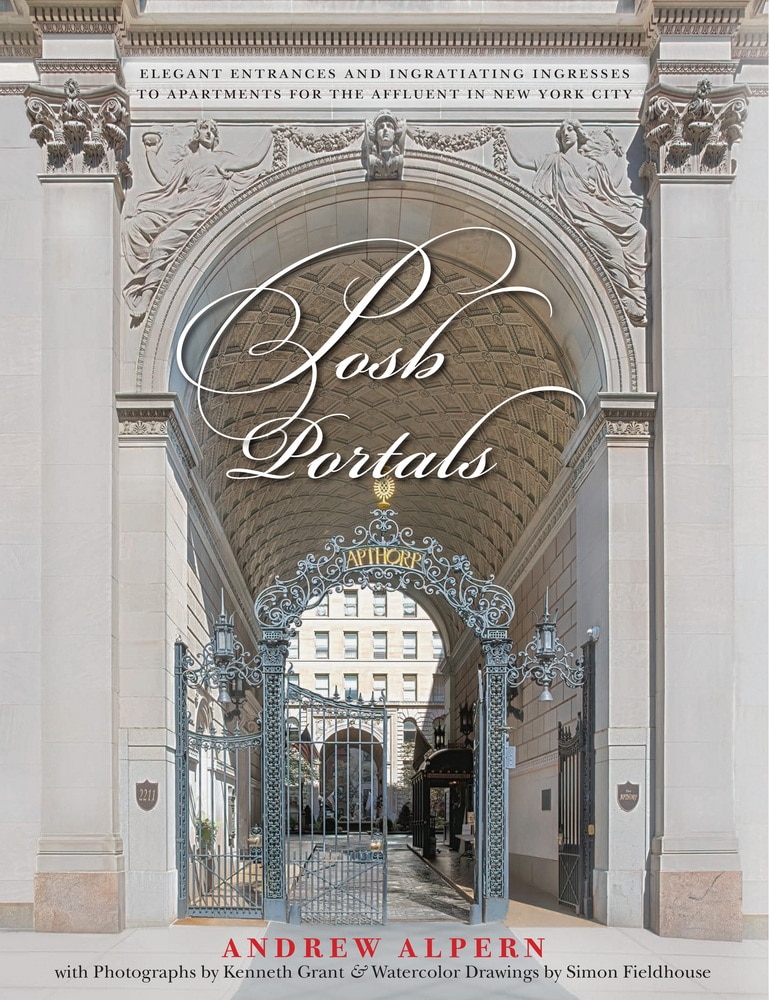I’ve been calling Posh Portals “my book” for years, though actually the author is noted architectural historian Andrew Alpern – who already had 10 other volumes published. But the cover and more than 350 inside photos are mine, and the watercolor illustrations are also based on my photos, so I really can’t be too objective, can I?
One of the reasons that I find architecture so fascinating is that buildings, like people, are so similar and at the same time infinitely diverse.
Take doors, for example. Every apartment building has to have a way in, obviously. It has to be substantial enough to keep out the elements, and large enough to permit occupants and their belongings to enter. So much for the similarities. The size, shape, material, style and embellishment, the scale, framing and placement of the front door are variables that together articulate the building’s character. A building’s portrait is never complete without an image of the front door.
In years of roaming cities with my camera, I’ve often shot doors and ignored the rest of the building. Some ancient, dilapidated dwellings – even crumbling tenements – were endowed with inviting portals. To the extent permitted by a developer’s budget, architects pride themselves on combining beauty with utility. One of the saddest parts of public housing is the cold steel front door, a mean, forbidding portal obviously designed more to keep people out than to invite people in.
In Andrew’s words, “The entrance to an apartment house is that important first impression, the opening sentence of the architectural story that sets the mood of the apartment building. A successful apartment house entrance must perform several functions, all of which must be kept in a delicate balance, consistent with the program that the developer has laid out for the architect to fulfill. The entrance is the dividing line between public and private space. It must make clear to the passer-by that he may approach and enter only if he has legitimate business within. Yet that entrance cannot be as forbidding as a fort, nor as evidently guarded as a prison, as it provides entrée to the homes of its residents, who may be the hosts of the approaching visitors.”
Here, then, is a collection of New York City’s most luxurious and distinctive apartment buildings, each endowed by their architect with entrances that speak volumes.
While these Posh Portals are no accident, my role this collection is definitely a case of serendipity. Your humble photographer was walking south along New York City’s Central Park West, an avenue lined with magnificent architecture. Out of the corner of my eye I noticed a distinguished-looking gentleman sitting on a bench across from the famed Dakota; there was something familiar about him . . . A few steps later it clicked: “Andrew?” I asked, approaching the bench. “Ken?” he replied. Until this morning, we had only seen photos of each other, though we had conversed almost five months about photos for his book, “The Dakota – A History of the World’s Best-Known Apartment Building.” He was waiting for a friend, and Andrew described a project he and Australian artist Simon Fieldhouse were discussing, an illustrated guide to the elaborate and ornate entrances to New York’s luxury apartment buildings. They’d need a good source of photos . . .
And so, from this chance meeting on a sunny January 13, 2014, my camera and I became part of Posh Portals. It’s been fun, educational, and sometimes challenging: Photographing buildings from street level in New York puts you at the mercy of the sun, traffic, parked trucks, and scaffolding that sometimes stays in place for years. The project took less than six minutes to describe, more than six years to complete, and was worth every second.
While obviously I’d LOVE for you to buy the book (shameless plug) from Amazon.com, photographs from Posh Portals are also available as framed or unframed prints on heavy paper, acrylic, or metal in a variety of sizes and styles. Just visit my Posh Portals photo gallery.
My gallery could not include the watercolor drawings by Simon Fieldhouse, but you can contact the artist at www.simonfieldhouse.com/new-york-apartment-entrances/.
